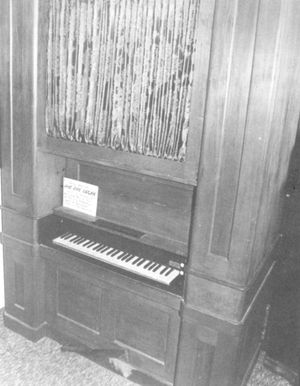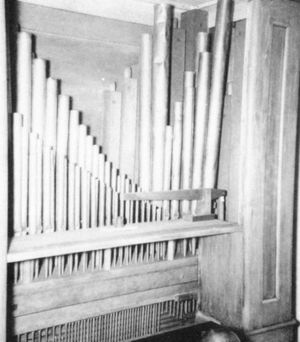

Marshall Historical Society |
|
The Ely Pipe Organ
Arthur H. Sanders |
|
This lovely old pipe organ has an interesting history -- much of it associated with one of the more colorful families of this vicinity. It was purchased new in 1830 to provide music for the home of Thomas and Louisa Ely (pronounced Eee-Lee), in their newly established homestead on the California Hill road, east of Deansboro, NY. It was a hop farm and in those days vast sums could be made farming hops. The land had not always been hop land, however. It was tract number 57, of 400 acres, bought from the Brothertown Indians by Thomas Ely's father shortly after 1795 with the plan of establishing a home and hop farm. Thomas was born in 1799, and worked with his father and the men at a young age, setting hop poles and stringing vines. Thomas married Louisa in 1825 and, shortly after, bought her an exquisite pipe organ. Louisa enjoyed playing her pipe organ, much to the delight of the growing group of settlers in the nearby communities of Deansboro, Waterville, Paris Hill and Clinton. Both Thomas and Louisa were Spiritualists, who believed that their relatives and friends who have "passed on" to spirit life, are trying to communicate with the living. Several confirmations occurred during sittings at the Ely homestead. Chairs were moved from their usual places, voices and tappings were heard, windows cracked, and writings were found. With the pipe organ to create the proper mood, the Ely homestead became a popular place for Spiritualist meetings. It was rumored the famous Fox sisters once visited for several days. Thomas and Louisa eventually passed on, and their son Frank was only mildly interested in the sect, and the congregation began meeting in other homes. Frank had brought a wife, Lotti, to the homestead in 1860 and in 1862, a daughter was born whom they named Belle. As a youngster, this "tom-boy" trained and drove a pair of goats hitched to a small wagon. She used to enjoy hiking and fishing with older friends, staying up all night. She was a large boned, tall, free-spirited woman, well able to take care of herself. Belle was popular, and she gave some parties unusual for this area. Farmers from as far as a hundred miles away would attend these four and five day gatherings. Nearly every Sunday, a group of Belle's friends would come to the house. There would be talk, some showing of horses and livestock some games, but later on everyone gathered around the old pine pipe organ. With Belle playing, the walls would be vibrating with singing. Many of the older residents of this area recalled with pleasure the sight of big Belle Ely riding behind her high-spirited team of black stallions in the 1980's and 90's. She used to delight in racing around the countryside in her cutter, probably checking on invitations for her next party. But it was a sight -- horses in full trot, sleigh bells jingling, and Belle with reins and whip, her brown hair flying in the wind. Belle's wedding was typical of her. There were thirty people at the house supposedly attending another party. Everyone was deep in song around the pipe organ when, about midnight, the Presbyterian minister from Clinton walked in. Belle and Bill Kimball -- assistant farm manager -- stepped up and were married. Certainly a wild party that night. |

|
There are 54 keys, playing two ranks of pipes. The principal has 54 unstopped metal pipes; the stopped diapason rank is wooden -- the larger ones four feet long and six inches square. The pine case was stained with sour milk and has a deep reddish glow, often called pumpkin pine. It measures 87 inches tall, 58 inches wide, and 27 inches deep. |

|
This organ may be one of the first constructed by Alvinza Andrews, who started making organs in 1830 in Waterville, NY. About 1852 he moved the factory to Utica, and his son, George L. Andrews, entered the firm. There are other Andrews organs at Vernon Center Presbyterian Church, the Constantia Episcopal Church, and the Deansboro Methodist Church. |
| This article appeared in several of the publications of the Musical Museum. | |
| Web master: lcgilley@tds.net | © 2007 - Marshall Historical Society |